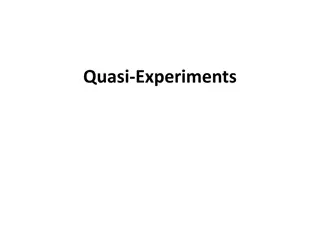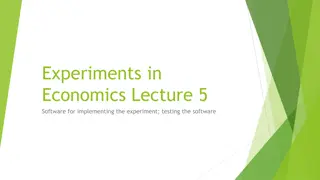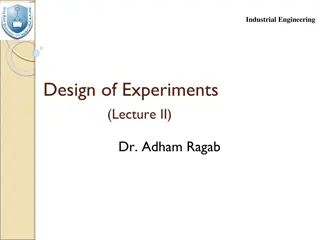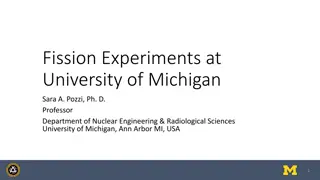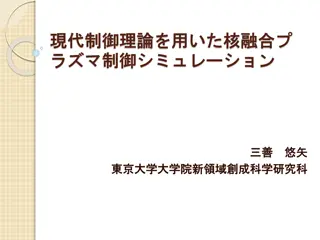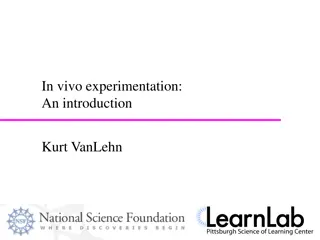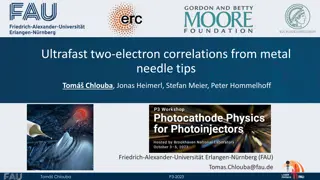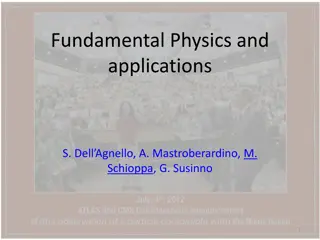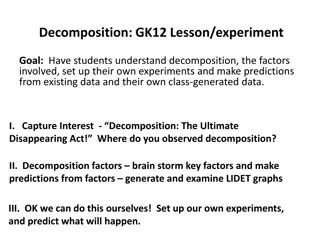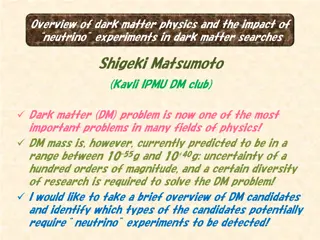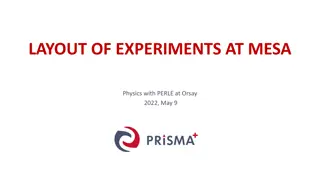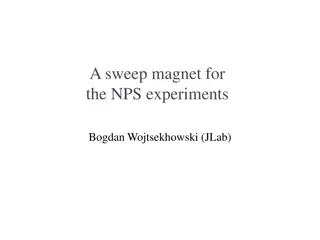Implications of TFTR D-T Experiments for ITER
D-T experiments differ from D due to isotope effects, transport mechanisms, wave-particle interactions, and alpha-particle physics. Changes in ion thermal conductivity, isotope effects on confinement, and isotope scaling variations in different operating regimes are discussed. The impact of neutral beam power on transitions in D-T experiments is also explored.
Download Presentation

Please find below an Image/Link to download the presentation.
The content on the website is provided AS IS for your information and personal use only. It may not be sold, licensed, or shared on other websites without obtaining consent from the author.If you encounter any issues during the download, it is possible that the publisher has removed the file from their server.
You are allowed to download the files provided on this website for personal or commercial use, subject to the condition that they are used lawfully. All files are the property of their respective owners.
The content on the website is provided AS IS for your information and personal use only. It may not be sold, licensed, or shared on other websites without obtaining consent from the author.
E N D
Presentation Transcript
Implications of TFTR D-T Experiments for ITER R.J. Hawryluk May 23, 2014
How are D-T Experiments Different from D? Isotope Effects Transport Wave-particle Interactions Alpha-particle Physics Technology Discussed in DT prep talk This talk on TFTR will not be comprehensive but will provide some highlights to hopefully encourage further research. Extensive references are available. Also see JET experimental papers for a complementary view.
Ion Thermal Conductivity Changes with <A> Depending on Operating Regimes JET TFTR factor of 2 Cordey S. Scott, M. Zarnstorff In JET H-modes, iscaling in the core consistent with gyro- Bohm. thcore <A> -0.16 0.1 In TFTR Supershots, confinement dramatically improved in the core and i decreased Ethermal <A>0.89 0.1 itot <A>-1.8 0.2 ITG model with radial electric field reproduced the Ti(r) profile, (Ernst) I <A>0.73 0.4 Pedestal scaled favorably with <A> improving
Isotope Effect on Confinement Varied Widely Depending on Operating Regime S. Scott, S. Sabbagh, C. K. Phillips Diversity of scalings challenges theory and gyro-Bohm scaling: <A>-0.2 ITER scaling for ELMy H-mode: Ethermal <A>+0.19
Favorable Isotope Scaling Not Observed in Reverse Shear Experiments 4 TFTR Set # 3 3 Set # 2 d i a ( M J ) 2 W Legend Set # 1 Pco/Pinj 0.60 - 0.65 0.45 - 0.75 0.40 - 0.62 0.45 - 0.55 D DT 1 NBI Prelude Scott 0 0 5 10 15 Pinj(MW) 20 25 30 35
Power Threshold on JET Going from L to H-mode Shows Favorable Isotope Scaling 8 Hydrogen ER98.026 JET Deuterium Tritium 6 DT PLOSS (MW) 4 2 wall loading series cryompump off 25:75 DT 10:90 DT Righi 0 0 2 4 6 8 1.12Bt 0.69R2 0.83ne Ploss <A>-1
Higher Neutral Beam Power Required for Enhanced Reverse Shear (ERS) Transition in D-T M. Bell, S. Scott, M. Zarnstorff Challenge for theory: same or lower threshold expected Was this a transport effect or a consequence of the beam deposition profile being different?
Summary of Isotope Effects on Confinement H-mode isotope scaling studies on JET, together with the worldwide physics database, provide a good technical basis for baseline operation of burning plasma experiments. Isotope scaling for E and power threshold. Understanding of isotope scaling is incomplete since it depends on operating regime. Not consistent with naive turbulence theory scaling What is the role of radial electric field shear in the different regimes? What are the implications for advanced operating modes? Power threshold for internal barrier formation increased with <A>. What are the implications for advanced operating regimes in ITER?
ICRF Successfully Heated D-T Supershot Plasmas in TFTR Te due to direct electron and 3He minority ion heating Ti due to 2nd harmonic tritium heating Power deposition calculations in good agreement with experiment. cHe3 to cT transition heating regime shown to give efficient heating suitable for ITER D-T plasma G. Taylor, J. R. Wilson, J. Hosea, R. Majeski, C. K. Phillips
Implications of ICRF Heating and Current Drive Studies Fundamental heating and current drive physics for ICRF has largely been established for D-He3 minority and second harmonic tritium heating experiments. Technology and coupling issues need to be further addressed for optimum ICRF application to ITER. Antenna power density limited by voltage standoff/coupling resistance.
In 1988 D-T Plan Little Attention Was Given to Alpha Physics on TFTR
By 1993 Realized that TFTR Could Contribute to Alpha Physics Studies
Alpha-particle Physics Studies MHD Quiescent Alpha-particle heating MHD Affects on Alpha Confinement Alpha-Particle Induced MHD Activity
Alpha-Particle Parameters in TFTR/JET Sufficient to Begin Study of Alpha-Particle Physics TFTR JET 10.6 ITER 400 0.55 1.2 4.0 1.9 Pfusion(MW) p (0) (MW/m3) 0.28 ( )% R grad( )%2.0 V (0)/VAlfv n(0)1.6 16.1 0.12 0.7 2.3 1.6 0.26 A. Fasoli
Classical Alpha Particle Behavior was Confirmed for Normal Shear (Supershot) Discharges TFTR Escaping alpha flux at 90o detector was consistent with classical first orbit losses Alpha birth rate and profile agreed with modeling. - Neutron flux in good agreement with calculations based on plasma profile in normal shear discharges. R. Budny, L. Johnson S. Zweben, D. Darrow
Alpha-particles Were Well Confined in Normal Shear (Supershot) Discharges TFTR Confined alphas in the plasma core showed classical slowing down spectrum. Alpha particles were well confined. 0 D 0.03 m2/s Rapid ash transported from the core to the edge in supershots. (DHe/ D ~ 1) R. Fisher, S. Medley, M. Petrov R. Fonck, G. McKee, B. Stratton E. Synakowski ITER will extend these results especially ash buildup.
Initial Evidence of Alpha-particle Heating on TFTR and JET TFTR JET Te(R) (keV) Te(R) (keV) Te(R) (keV) Te(R) (keV) Te(0) (keV) G. Taylor, J. Strachan Te(DT) - Te(D) (keV) P. Thomas, et al. P (MW) Alpha heating ~15% of power through electron channel. Palpha/Pheat ~12% - 30-40% through the electron channel Comprehensive study of alpha heating requires higher values of Palpha/Pheat .
TAE modes Driven by Neutral Beams and ICRF were Discovered on TFTR. ICRF induced TAE with ripple trapping damaged the vessel during D-T operations. In normal shear D-T discharges, TAE was stable. E. Fredrickson, D. Darrow, S. Zweben
TFTR Alpha-particle Physics Studies in Reversed Shear Discharges Resulted in New Discoveries. Alpha-driven TAE (subsequently identified as Cascade Modes) were observed. TAEs redistributed deeply trapped alpha-particles Neutron emission in D-T enhanced reverse shear discharges disagreed with TRANSP analysis in some shots by factors of 2-3 Source of discrepancy was not identified. R. Nazikian, Z. Chang, G. Fu S. Medley, M. Petrov,
Compatibility with Plasma-Boundary Interface Was a Key Issue Conditioning the machine for supershots was critical Led to the use of lithium wall coatings to improve performance Many of the lithium coating techniques were developed or optimized during the DT campaign! Power handling (carbon blooms) were a constraint. Substantial tritium retention in graphite was observed in JET and TFTR experiments. TFTR tiles 16% retention JET 12% retention Recent retention results from JET with ILW are encouraging Plasma behavior is different with W (disruptions, pedestal, ELMs .) ITER will provide a critical assessment of power handling, retention, impurity influxes, dust etc
TFTR D-T Experiments Were Exciting From the Start to the End
The Burning Plasma Research Program on ITER will Be Even More Exciting Results from TFTR and JET together with the results from the world-wide community have Provided a solid design basis for a burning plasma experiment. Experience on TFTR and JET D-T experiments is that new physics will emerge in ITER ITER will respond to what we will learn during the D-T experiments and the plans will be revised. Full potential and consequences of alpha heating have not been explored! Congratulations and thanks to the TFTR Team for beginning the exploration of D-T!
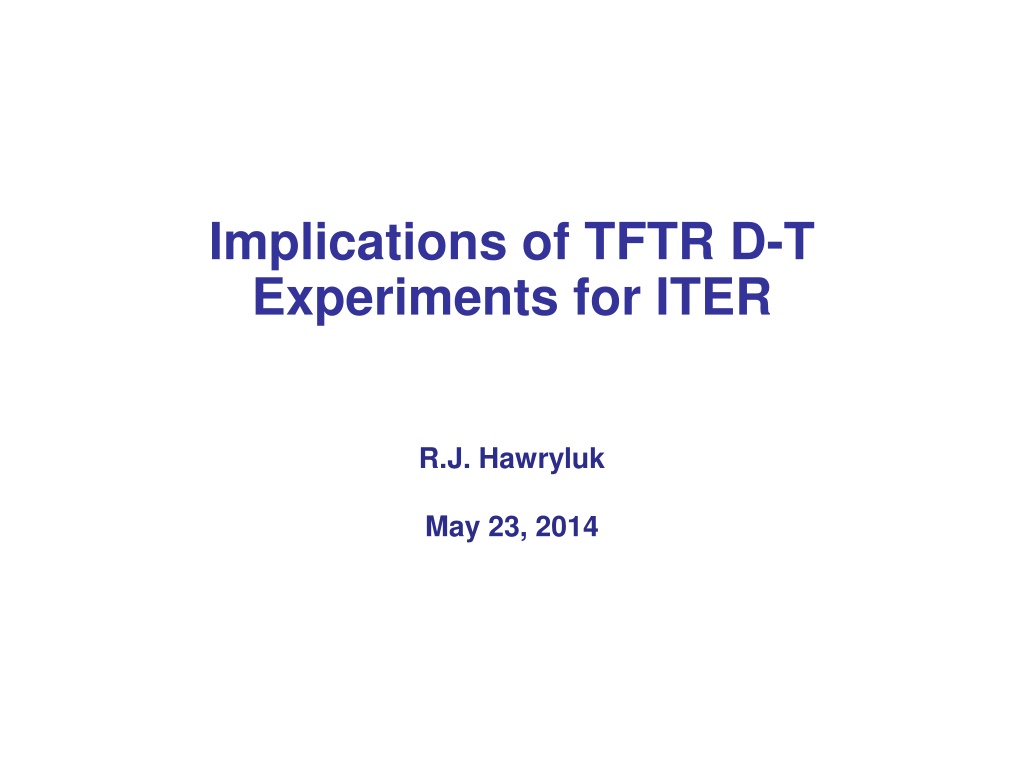

 undefined
undefined

